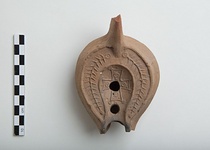|
|
Corinth Basket: Nezi Field, context 896 | Collection: | | Corinth | | Type: | | Basket | | Name: | | Nezi Field, context 896 | | Area: | | Nezi Field | | Title: | | Red clay triangle along N scarp with tile | | Category: | | Deposit | | Notebook: | | 1106 | | Context: | | 896 | | Page: | | 0 | | Date: | | 2012/06/08 | | Lot: | | Lot 2012-050 | | Stratum: | | pottery, 20% tile, bone, pebbles, few cobbles, much glass, lamp, carbon. Inclusions 30%. | | Description: | | The soil color is light reddish brown. The soil compaction is compact. The soil is poorly sorted. It is clayey silt. | | Notes: | | Found nearly intact lamp within first few minutes of digging. Also glass stemmed goblet base (tubular ring foot, concave). This is a roughly triangular area that was last excavated as 836, in session 2. We stopped digging then because Panos thought the pile of tiles on its surface at the bottom of 836 might represent a destruction tile fall. Guy disagreed. We have left it alone for so long because the pottery dated to the 6th/7th century AD, and because it seems to have been cut by all the contexts around it. Now, however, it can be seen to overlay a vertical accumulation of stones in the N scarp which we think may be another N-S wall (at ca. 269.50 to 270 E). We are removing this triangle prior to digging the rest of the tile destruction layer (see 886/879) that can be seen in the N-S scarp S of wall 866's S end, in hopes of clarifying the stratigraphy in the N and W of wall 866 before tackling the tile destruction S and W of wall 886. It would also be nice to find a good W limit to the tile destruction from above, rather than digging into it sideways.
More glass, one largish flat green piece. Soil along N edge is slightly darker and contains more roots from plants that were growing along the scarp, but we think it is the same - tile fragment lies across apparent line between soils, where root action, erosion, etc. are causing a chunk of soil to separate and slide down off scarp. Large amount of glass for so small a context. Since tiles are no longer present and small edge of context on W side is blacker, we will be switching contexts to 898 (black soil), then removing the rest of the red clay triangle (899). | | Context Pottery: | | Cooking ware. stewpot tapering rim1 rim. (saved to lot) .; Cooking ware. stewpot1 rim. (saved to lot) .Hesperia 2005 3-30; Coarseware. egyptian amphora1 rim. 5 bodysherds. (saved to lot) .; Fineware. askra beaker1 rim. (saved to lot) .; Fineware. Pre-Roman11 bodysherds. (saved to lot) .; Fineware. unidentified red slip trianglular rim1 rim. (saved to lot) .spirally burnished; Fineware. Early Roman3 bodysherds. (saved to lot) . | | Pottery Summary: | | 17 frag(s) 0.45 kg. (100% saved) fineware. | | | | 163 frag(s) 2.46 kg. (100% saved) coarseware. | | | | 54 frag(s) 0.56 kg. (100% saved) cooking ware. | | Context Artifacts: | | glass, clear, colorless, rim, 2; glass, clear, green, faceted form, bs, 1; glass, clear, light blue, tubular ring foot, sloping profile, stemmed goblet, base, 1; glass, clear, light blue, rim, 1; glass, clear, colorless, bs, 3; lamp as L69-285, 1 | | Period: | | Late Roman (5th -6th c AD) | | Chronology: | | Late Roman 7th npd | | Grid: | | 270.68-267.6E, 1012.16-1014.2N | | XMin: | | 267.6 | | XMax: | | 270.68 | | YMin: | | 1012.16 | | YMax: | | 1014.2 | | Site: | | Corinth | | City: | | Ancient Corinth | | Country: | | Greece | | Masl: | | 86.51-86.66m. | | References: | | Report: Nezi Field 2012 by Kyle Mahoney and Rachel McCleery (2012-05-28 to 2012-06-15)
Object: L 2012 3
|
|
|
